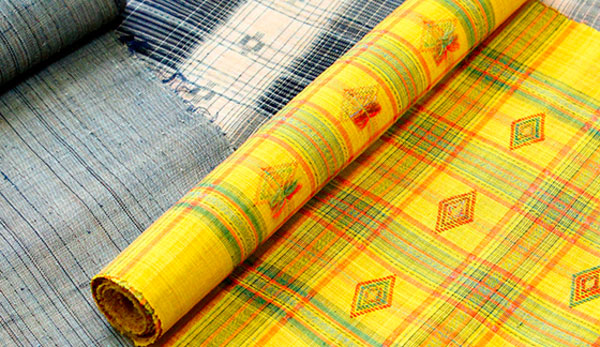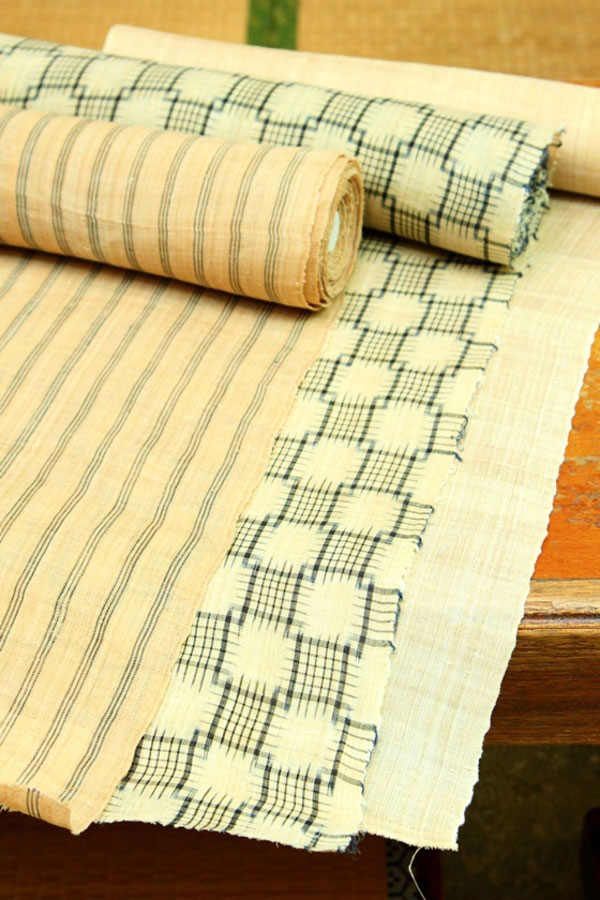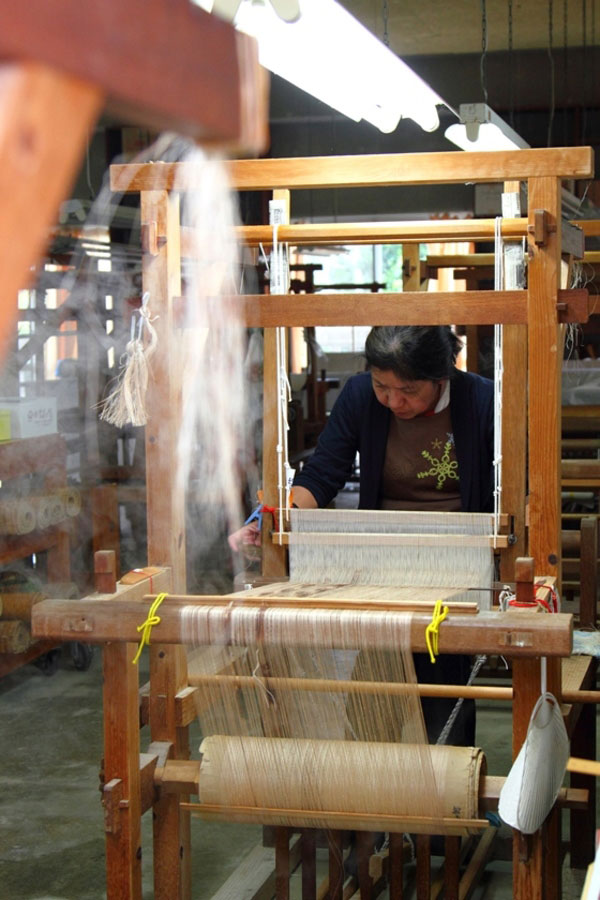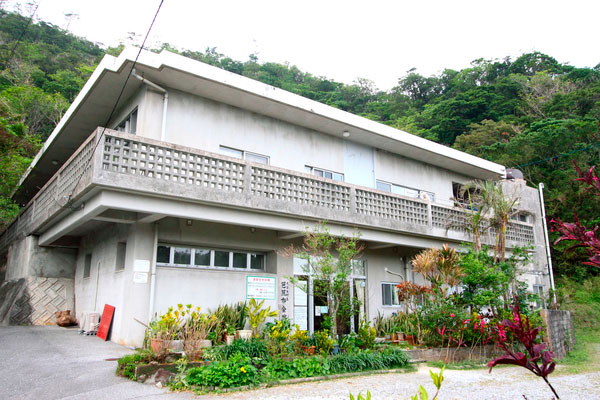 Photo:Okinawa Convention&Visitors Bureau
Photo:Okinawa Convention&Visitors Bureau
- Woven textiles
- Okinawa
Kijoka banana fiber cloth Kijoka no bashofu
Simple and natural 100% handmade fabrics
reflecting the climate of Okinawa
Description
What is Kijoka banana fiber cloth ?
Kijoka no Bashofu are a woven cloth produced in Kijoka, Ogimi Village in northern Okinawa. Bashofu is made from the fibers of the Japanese banana plant called Basho, and has been used to make kimonos in Okinawa since ancient times. Kijoka no Bashofu is characterized by its smoothness, lightness and air permeance. The firm and thin cloth, also described as “wings of a dragonfly,” are less likely to stick to the skin even in a humid climate and have been highly valued by people in Okinawa. Though Basho trees grow naturally in Okinawa, the people in Kijoka cultivated the trees to obtain better threads. The cultivation process, from pruning to producing threads, requires three years. Harvested Basho trees undergo manual pretreatment before producing fiber threads. It takes three months to weave a bolt of Bashofu from tree harvesting, and sixty trees are necessary. Kijoka no Bashofu is often called a phantom woven fabric because it employs the integrated, manual production process, from cultivation through dyeing and weaving with local materials, which is seldom found anywhere else in Japan.
History
 Photo:Okinawa Convention&Visitors Bureau
Photo:Okinawa Convention&Visitors Bureau
Bashofu is said to have been produced in Okinawa for a very long time since around the 13th century. During the Ryuku Dynasty period, a position specializing in management of the Basho gardens within the royal government was established in order to obtain high quality Bashofu for the royal family and aristocrats. Later, common people also began to wear Bashofu, and Bashofu was produced at regular homes for home use. Bashofu was mostly plain colored or striped, but in 1895, the women in Kijoka started to make kasuri (splashed pattern) Bashofu, and it then developed as a craft. Production of Bashofu increased as a side business for farmers, and was highly valuated at competetive exhibitions. They exhibited Bashofu at an exhibition and sale held at Mitsukoshi Department Store in Tokyo in 1939 where Bashofu drew significant attention and became widely known. Production of Bashofu stopped during World War II, but the industry was reconstructed immediately after the war ended in 1945. In 1972, Bashofu was designated as an intangible cultural asset, and this valuable cloth continues to be produced in Kijoka, home of Bashofu, up to this day.
Production Process
 Photo:Okinawa Convention&Visitors Bureau
Photo:Okinawa Convention&Visitors Bureau
- 1. Cultivation of Japanese banana plant and peeling
The skin of harvested Japanese banana plant is peeled by hand. The onion-like stalks are peeled apart layer by layer from the outside with a knife to separate them into four groups. The outmost hard layer is used for small products such as tapestries, while the inner layers with softer stalk fibers are suitable for kimono. The inmost layer is used for dyeing.
- 2. Boiling
The peeled banana plant skin is boiled in a wood-ash solution. The banana plant fibers become soft when boiled in the alkaline wood-ash solution. Adjusting the strength of a wood-ash solution is sensitive work as a strong solution containing strong alkali causes fibers to break, but if the solution is too weak, the fiber does not become soft enough.
- 3. Stripping the fibers
A bamboo scraper is used to scrape the skin of the boiled banana plants to collect silky fibers from inside. Cleaned fibers are dried in a place where there is no wind and sorted according to the softness of the fibers. Soft fibers are suitable for weft threads and hard fibers for warp threads.
- 4. Making threads The dried fibers are spooled into small-sized balls called chingu and the fibers are tied together one by one to make a long thread. The stalk fibers are about 1.5m in length at first, but will be formed to be threads long enough for weaving. The fibers are tied together manually, but to make the tied knots inconspicuous is an arduous task that requires patience and elaborateness. This stage determines the quality of the finished Bashofu.
- 5. Twisting and warping
The threads are twisted before dyeing to prevent any fraying. The threads are misted with water during this process and the length of the threads is adjusted.
- 6. Knotting
With the threads stretched transversely, sections to keep undyed are wrapped with banana plant skin and tied with a string to secure. This is a difficult process as the threads may break if tied too tightly and dyed if tied too loose.
- 7. Dyeing
Bashofu are dyed with plant-dyes including Acacia Confusa and Assam indigo. Assam indigo is especially a delicate dyeing solution that needs to be checked on constantly. Kasuri design patterns in the fabric are dyed by tying the threads with the banana plant skin to highlight the patterns. Regularly-arrayed dyed threads realize meticulous patterns in the design.
- 8. Preparation for weaving
After a long process to prepare the threads, the dyed threads are set up on the loom to be woven once the warp threads have been spooled.
- 9. Weaving
The weaving process accounts for only one percent of the whole process of Bashofu production. As Basho threads are vulnerable to dryness and can easily break on sunny days, the rainy season is considered the perfect time for weaving. Today the weaving can be done throughout the year while keeping the threads moist by applying water with a spray bottle while weaving, but weaving with these delicate threads still requires much concentration.
- 10. Cleaning
The woven Bashofu at this point cannot be used as a product as the threads are still fragile. The woven fabric is washed and scrubbed with water and is then again boiled in wood-ash solution. It is then soaked in an acid solution made from fermented rice-washed water to neutralize the alkaline fabric to give it strength. The fabric is stretched to its correct width and length by tugging both ends, and is polished gently with a ceramic cup as a final ironing.
Facility Information
Ogimi Bashofu Kaikan
 Photo:Okinawa Convention&Visitors Bureau
Photo:Okinawa Convention&Visitors Bureau
-
Address
-
Tel.+81-980-44-3033
-
ClosedSundays, Tuesdays, August 13 to 16 and around the New Year
-
Business Hours10am to 5pm
-
Website
Other Woven textiles
- Nishijin brocade
- Yuki tsumugi silk
- Kurume traditional resist-dyed textiles
- Ojiya chijimi textiles
- Hakata brocade
- Ushikubi tsumugi silk
- Chichibu-meisen silk
- Miyako ramie textile
- Shiozawa tsumugi silk
- Kumejima tsumugi silk
- Omi ramie cloth
- Ryukyu traditional resist-dyed textiles
- Kiryu brocade
- Murayama-oshima tsumugi silk
- Yumihama traditional resist-dyed textiles
- Chibana-hanaori textiles
- Hon-shiozawa silk
- Oitama tsumugi silk
- Ojiya tsumugi silk
- Yaeyama cotton cloth
- Yaeyama ramie cloth
- Honba oshima tsumugi silk
- Shinshu tsumugi silk
- Shuri brocade
- Tama brocade
- Yomitanzan-hanaori textiles
- Isesaki traditional resist-dyed textiles
- Hachio island silk
- Nibutani bark cloth
- Uetsu tilia bark cloth
- Awa-shijira cotton cloth
- Kijoka banana fiber cloth
- Tokamachi traditional resist-dyed textiles
- Tokamachi akashi chijimi textiles
- Yonaguni brocade
- Yuntanza minsa
- Flower pattern textiles
- Oku-Aizu Showa Karamushi Textiles
Other Crafts Made in Okinawa
- Tsuboya ware
- Miyako ramie textile
- Ryukyu lacquerware
- Kumejima tsumugi silk
- Ryukyu traditional resist-dyed textiles
- Chibana-hanaori textiles
- Yaeyama cotton cloth
- Yaeyama ramie cloth
- Shuri brocade
- Yomitanzan-hanaori textiles
- Ryukyu traditional textiles
- Kijoka banana fiber cloth
- Yonaguni brocade
- Yuntanza minsa
- Flower pattern textiles
- Sanshin































































































































































































































































































